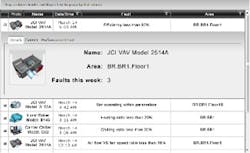Latest from Building Automation
New HVACR Products: March 2025
Crete United to Partner with ProStar Energy Solution
Modular Construction Still Gaining Ground
ASHRAE 90.1: Charting the Path to Net Zero Buildings
New HVACR Products: February 2024
AHR Sessions: Our Collection of Field Reports
HPAC 2024: Our February Quiz!
Fault Detection: A Great Building-Operations Resource
Fault detection helps facilities engineers and building-operations staffs identify operational and energy-efficiency improvements that can be made to building systems. Fault-detection systems are programmed as an overlay to or integrated into energy-management systems (EMS) to highlight problems before they occur. Fault-detection software can be set up with dashboards or “ticklers” designed to recognize issues before they become alarms or failures.
A fault-detection program can be set up to ascertain the present condition or health of a system, and determine if the level and/or performance of the system are within specified goals. This software application can be programmed with specific reasoning to not only determine the fault, but also help determine its cause, help the operator correct the issue, and rank or prioritize issues based on how critical they are. This ranking can be broken down and categorized by critical systems, priorities can be set by systems or areas of the building, and the application installer can program the system to calculate the energy or maintenance cost lost if the fault is not corrected. Fault-detection systems can be set up to function automatically.
Another important facet of fault detection is the ability to set up a continuous commissioning of large numbers of equipment assets, constantly alerting operators on efficiency and maintenance faults.
Fault detection can improve the efficiency of a maintenance department. Real-time fault detection and diagnostics technology can assist with commissioning as well as make recommendations as to where a staff should focus its efforts to make improvements. It works by predicting equipment faults and looking for energy offenders before they occur. When failures occur, automated diagnostics analyze sensor readings and provide a list of probable causes of failure and guidance to the service technician. This reduces the mean time to diagnose, and helps cut maintenance costs.
For example, if a building has laboratories or other areas that need to maintain a particular temperature, a fault-detection application can be programmed to ensure that temperature is maintained and to issue a fault if the space is outside the normal range. It would not send an alarm, but would indicate a system that needs particular attention or service, such as a coil that needs cleaning. Fault detection could determine if a system might fail in the future to help focus the maintenance staff on issues before they become problems.
As another example, let’s say the CEO of a company has a troublesome HVAC system. A building maintenance staff could set the fault detection to critical for that company’s space and respond to it before the employees complain. No one likes to fail or to respond to issues late. By responding before problems occur, the staff would be viewed as good planners and well organized.
The energy or maintenance cost function could help a maintenance staff determine which tasks are to be done and which issues are addressed first. It is always embarrassing when an entire staff is changing filters and a main air-handling unit goes down. Fault detection also prevents micromanagement of staff by helping them understand priorities without supervision. The difference between the command or goal and the actual measured result is the fault.
If you are interested, you can consult your system integrator or BAS service company for more information. If they are not sure of what you are talking about, it may be time to look for another partner.
J. Christopher Larry PE, CXA, CEM, CEP, CIPE, LEED AP, is the Director of Energy Engineering for exp, in Richmond, VA. He has spent more than 25 years working to minimize the building industry’s energy and environmental footprint through refining building design, building modeling, performance optimization, and intelligent controls. He won “Energy Engineer of the Year in 2000 from AEE. He has held numerous positions within ASHRAE, including chairman of the Chapter Technology Transfer Committee and chairman for Technical, Energy and Governmental Activities. He is a past president of the Association of Energy Engineers (AEE) and has instructed the certified energy manager training course for AEE. He is the current chairman for the Building Intelligent Quotient (BIQ) within the Continental Automated Buildings Association (CABA) and also is a member of the Zero Energy Commercial Building Consortium.










